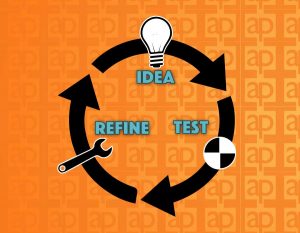
Validating Product Ideas: Testing Your Assumptions
You know what happens when you assume? That’s right! So, before we make a prototype or get into all of the details of creating your product, let’s test those assumptions and avoid making an a** out of you and me.
When we come up with product ideas, we generally start with a series of assumptions about what we think the product will do or how the consumer will interact with it. They are explicit but rarely will they be 100% right from the start. Our most basic assumptions will probably relate to the value the product brings to the customer and the potential it has for widespread growth.
How devastating would it be to put blood, sweat and a few tears into a product only to find out that there’s no need or want for it? I can hear the sound of toilets flushing as your money, time and energy go down the drain. If we test these pre-established ideas or hypothesis from the beginning we can create a continuous loop to evaluate and refine our ideas during the lifetime of the product.
How to Test?
I know it can be a little intimidating to consider the whole process of market or customer research: what do I do? Where do I start? How will I find the time to do it? It’s important to figure out what methods will work for you. One way is pretty simple and cost-effective: interviews. Think about who you are targeting. Your potential consumers are the best way to gain insight into whether your assumptions are correct.
When interviewing potential customers:
- Have fluid, unscripted conversations and be open-minded about where the conversation may lead you
- Don’t talk about your product or solution.
- Don’t talk about the future, no hypotheticals, predictions, etc. This will skew your results.
- Don’t ask questions with the word “would in it.” Example: If there was a product, would you…”
- Take detailed notes or recordings to build a database
- Work towards building 3+ customer avatars.
- Don’t only focus on what people say, pay attention to how they say it.
Conversations like these are the basis for building customer avatars or personas, which are fictional, generalized profiles of your ideal users.
Here is an example of a customer avatar or persona:
Susan A:
32 Year old, computer science major. Graduated from X University (or not at all). Married with a 3 year old daughter. Lives in X city. Frustrated about rising transportation costs. Can’t find housing close enough to her place of work. Yearly income approx. 45k/year. Etc etc.


If your product is a B2B product. Research different types of decision makers and how your product could be a priority purchase for them.
If you have a website or blog, you have an excellent opportunity to conduct market research. In most cases, the people visiting your website and reading your blog are a part of your target audience, and exactly the people you want to hear from. You can create a poll that is a standard part of your site, or design a survey that is incorporated into an opt-in form to gather input. Also, social media is great for getting feedback. Put those Twitter fingers to use in engaging in meaningful interactions with potential consumers.
What Will I Gain?
Some feedback that you will get includes:
- How often would people use the product or service
- How much they would be willing to pay (if at all!)
- What the most useful features are for them
- How they would access the product
- Other potential revenue streams
- And (Most Importantly) WHY they would buy your product. People buy the “Why” your product is before they buy “What” your product is.
That’s right, testing your idea might help you discover something entirely new. Maybe your product would best suit a segment of the market you hadn’t thought about? Or, maybe your product could solve an issue which you hadn’t considered before?
Even if you decide that your product isn’t right at all and it ends up in the garbage, you have avoided wasted time and effort and will soon be on your way to testing your next big idea.
Wrappin’ it up
Doing problem research and potential customer interviews doesn’t have to be horrible. Keep in mind that this isn’t about you but, about your potential market. If they don’t like your product, build one for yourself and then find a product that people want or need. People’s opinions and ideas are a gold mine. Get out there and start mining them!
Download our Potential Customer Interview Template:
I’ve included a customer interview template just to help you come up with some simple questions and organize your notes. I only ask that you do one thing for me…please…PLEASE…have fun doing what you do, take it step by step and you WILL be successful.
